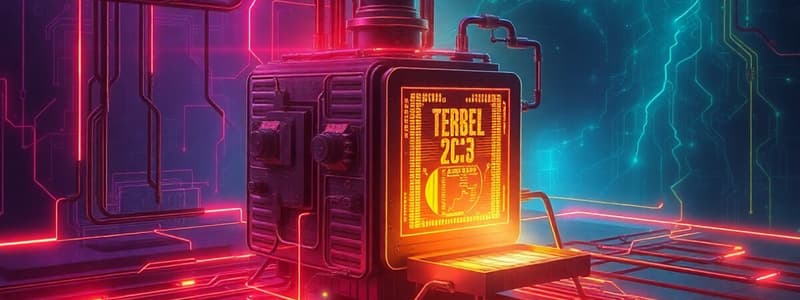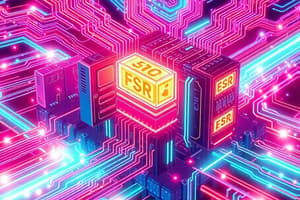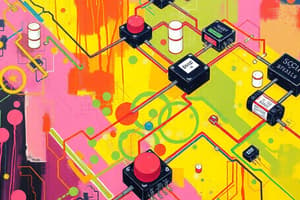Podcast
Questions and Answers
What is the main purpose of a Silicon Controlled Rectifier (SCR)?
What is the main purpose of a Silicon Controlled Rectifier (SCR)?
- To function as a general diode
- To convert DC current into AC current
- To amplify electric signals
- To control high power applications (correct)
How many terminals does a Silicon Controlled Rectifier have?
How many terminals does a Silicon Controlled Rectifier have?
- 4 terminals
- 2 terminals
- 3 terminals (correct)
- 5 terminals
What type of semiconductor layers make up a Silicon Controlled Rectifier?
What type of semiconductor layers make up a Silicon Controlled Rectifier?
- Three layers of n-type material
- Four alternating layers of p-type and n-type materials (correct)
- One layer of a composite semiconductor
- Two layers of p-type material
Which of the following terms is often used interchangeably with Silicon Controlled Rectifier?
Which of the following terms is often used interchangeably with Silicon Controlled Rectifier?
Who led the team of power engineers that developed the SCR?
Who led the team of power engineers that developed the SCR?
What are the three terminals of a silicon controlled rectifier?
What are the three terminals of a silicon controlled rectifier?
In which region of the V-I characteristics does the SCR not conduct electric current?
In which region of the V-I characteristics does the SCR not conduct electric current?
Which junctions are forward biased in the Forward Blocking Mode?
Which junctions are forward biased in the Forward Blocking Mode?
What happens when the SCR reaches the forward breakdown voltage (VBF)?
What happens when the SCR reaches the forward breakdown voltage (VBF)?
What happens when a positive voltage is applied to the gate terminal?
What happens when a positive voltage is applied to the gate terminal?
What defines the reverse blocking region in an SCR?
What defines the reverse blocking region in an SCR?
In which mode does the SCR exhibit high resistance and prevents current flow despite being forward biased?
In which mode does the SCR exhibit high resistance and prevents current flow despite being forward biased?
What is the primary role of a TRIAC?
What is the primary role of a TRIAC?
How does a TRIAC operate when MT2 is at a positive potential relative to MT1?
How does a TRIAC operate when MT2 is at a positive potential relative to MT1?
What phenomenon allows the SCR to conduct current during Forward Conducting Mode?
What phenomenon allows the SCR to conduct current during Forward Conducting Mode?
What is the role of the external resistance in a TRIAC circuit?
What is the role of the external resistance in a TRIAC circuit?
In which modes does a TRIAC conduct?
In which modes does a TRIAC conduct?
What is the primary characteristic of a DIAC?
What is the primary characteristic of a DIAC?
Which of the following is a disadvantage of using a TRIAC?
Which of the following is a disadvantage of using a TRIAC?
What is a primary application of a DIAC?
What is a primary application of a DIAC?
Which statement about the V-I characteristics of a DIAC is true?
Which statement about the V-I characteristics of a DIAC is true?
How does a DIAC switch from off-state to on-state?
How does a DIAC switch from off-state to on-state?
What happens to junction J2 during forward voltage triggering when the forward break over voltage is reached?
What happens to junction J2 during forward voltage triggering when the forward break over voltage is reached?
Which triggering method uses a light source to activate the SCR?
Which triggering method uses a light source to activate the SCR?
What is a critical drawback of using forward voltage triggering in SCR operation?
What is a critical drawback of using forward voltage triggering in SCR operation?
Which mode of SCR operation occurs when the anode is negative and the cathode is positive?
Which mode of SCR operation occurs when the anode is negative and the cathode is positive?
What triggers the SCR in the dt/dv method?
What triggers the SCR in the dt/dv method?
What phenomenon may occur due to temperature increase in an SCR?
What phenomenon may occur due to temperature increase in an SCR?
Which SCR triggering method is considered the most reliable?
Which SCR triggering method is considered the most reliable?
What should happen to the gate voltage after the SCR is turned ON?
What should happen to the gate voltage after the SCR is turned ON?
What is the impact of spurious voltage spikes on SCRs?
What is the impact of spurious voltage spikes on SCRs?
What is the primary function of a DIAC in a circuit?
What is the primary function of a DIAC in a circuit?
Which statement accurately describes the operation of a DIAC?
Which statement accurately describes the operation of a DIAC?
How does the two transistor analogy of SCR work?
How does the two transistor analogy of SCR work?
What happens to the SCR after it is triggered?
What happens to the SCR after it is triggered?
What characteristic of DIAC helps in reducing harmonics in a system?
What characteristic of DIAC helps in reducing harmonics in a system?
Which of the following is a disadvantage of using a DIAC?
Which of the following is a disadvantage of using a DIAC?
What role does the gate current play in SCR operation?
What role does the gate current play in SCR operation?
What does the regeneration process in SCR do after triggering?
What does the regeneration process in SCR do after triggering?
Which factor is critical for the reliable turn-on of an SCR?
Which factor is critical for the reliable turn-on of an SCR?
Flashcards
Silicon Controlled Rectifier (SCR)
Silicon Controlled Rectifier (SCR)
A 3-terminal, 4-layer semiconductor device used to control high power.
SCR's Layers
SCR's Layers
SCR is made of alternating semiconductor layers (P and N type).
SCR Function
SCR Function
Controls and converts high-power AC current to DC.
SCR's Application
SCR's Application
Signup and view all the flashcards
SCR's Key Advantage
SCR's Key Advantage
Signup and view all the flashcards
SCR Symbol
SCR Symbol
Signup and view all the flashcards
Forward Blocking Mode (SCR)
Forward Blocking Mode (SCR)
Signup and view all the flashcards
Forward Conducting Mode (SCR)
Forward Conducting Mode (SCR)
Signup and view all the flashcards
Reverse Blocking Mode (SCR)
Reverse Blocking Mode (SCR)
Signup and view all the flashcards
Silicon Controlled Rectifier (SCR) Construction
Silicon Controlled Rectifier (SCR) Construction
Signup and view all the flashcards
SCR Forward Blocking Region
SCR Forward Blocking Region
Signup and view all the flashcards
SCR Forward Conduction Region
SCR Forward Conduction Region
Signup and view all the flashcards
SCR Reverse Blocking Region
SCR Reverse Blocking Region
Signup and view all the flashcards
TRIAC
TRIAC
Signup and view all the flashcards
TRIAC Operation
TRIAC Operation
Signup and view all the flashcards
Triac Mode 2
Triac Mode 2
Signup and view all the flashcards
Triac Mode 3
Triac Mode 3
Signup and view all the flashcards
DIAC
DIAC
Signup and view all the flashcards
DIAC Triggering
DIAC Triggering
Signup and view all the flashcards
Triac On-State Current
Triac On-State Current
Signup and view all the flashcards
DIAC Symmetry
DIAC Symmetry
Signup and view all the flashcards
Triac Control Circuit
Triac Control Circuit
Signup and view all the flashcards
Forward Voltage Triggering
Forward Voltage Triggering
Signup and view all the flashcards
Light Triggering
Light Triggering
Signup and view all the flashcards
Temperature Triggering
Temperature Triggering
Signup and view all the flashcards
dv/dt Triggering
dv/dt Triggering
Signup and view all the flashcards
Gate Triggering
Gate Triggering
Signup and view all the flashcards
Forward Blocking Mode
Forward Blocking Mode
Signup and view all the flashcards
Forward Conduction Mode
Forward Conduction Mode
Signup and view all the flashcards
Reverse Blocking Mode
Reverse Blocking Mode
Signup and view all the flashcards
Forward Breakover Voltage
Forward Breakover Voltage
Signup and view all the flashcards
DIAC Advantages
DIAC Advantages
Signup and view all the flashcards
DIAC Disadvantages
DIAC Disadvantages
Signup and view all the flashcards
DIAC Application
DIAC Application
Signup and view all the flashcards
Two-Transistor Analogy (SCR)
Two-Transistor Analogy (SCR)
Signup and view all the flashcards
SCR Turn-On Mechanism
SCR Turn-On Mechanism
Signup and view all the flashcards
SCR Forward Biasing
SCR Forward Biasing
Signup and view all the flashcards
SCR Gate Triggering
SCR Gate Triggering
Signup and view all the flashcards
Holding Current (SCR)
Holding Current (SCR)
Signup and view all the flashcards
Positive Feedback (SCR)
Positive Feedback (SCR)
Signup and view all the flashcards





